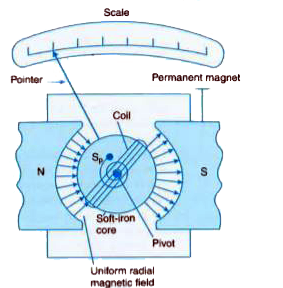(a) With the help of a diagram, explain the principle and working of a moving coil galvanometer. (b) What is the imporance of a magnetic field and how is it produced ?
(c) Why is it that while using a moving coil galvanometer as a voltmeter as a voltmeter a high resistance in series is required whereas in an ammeter a shunt is used ?
(a) A labelled diagram of a pivoted type moving coil galanometer has been shown in fig.
Principle , If a current coil is freely pivoted in a uniform magnetic field, hence on passing current I thorugh it a deflecting torque acts on the coil which is given by τ=NAIB
where N = total number of turns in the coil, A = area of coil , B = magnetic field.
The spring Sp attached to the coil provides the counter torque and in equilibrium state balances the deflecting torque. If ϕ be the steady angular deflection then counter torque is kϕ, where k = torsional constant of the spring.
In equilibrium state
NAIB=kϕ⇒I=kNAB⋅ϕ
Thus , deflection is directly proportional to the current.
(b) In a radial magnetic field the plane of the rotating coil always lies in the direction of magnetic field. Thus, torque on the coil remains constant (τ=NAIB) and does not change with angular deflection angle ϕ. Radial magnetic field is produced by making the pole piece of horse shoe magnet concave and by introducing a cylindrical soft iron core in the middle of galvanometer coil.
(c) A voltmeter mus draw a very small current so as to given correct voltage measurement. Therefore, a high resistance is connected in series with the galvanometer.
An ammeter should have negligible resistance so that its presence does not alter the circuit current. Therefore, a small shunt resistance is connected in parallel to the galvanometer so as to reduce its resistance.

Topper's Solved these Questions
- BOOK - U-LIKE SERIESCHAPTER - MOVING CHARGES AND MAGNETISM EXERCISE - SELF ASSESSMENT TEST (SECTION A) (MULTIPLE CHOICE QUESTIONS)5videos
MOVING CHARGES AND MAGNETISM
- BOOK - U-LIKE SERIESCHAPTER - MOVING CHARGES AND MAGNETISM EXERCISE - SELF ASSESSMENT TEST (SECTION A) (FILL IN THE BLANKS)3videos
MOVING CHARGES AND MAGNETISM
- BOOK - U-LIKE SERIESCHAPTER - MOVING CHARGES AND MAGNETISM EXERCISE - LONG ANSWER QUESTIONS-I33videos
MOVING CHARGES AND MAGNETISM
- BOOK - U-LIKE SERIESCHAPTER - MODEL TEST PAPER 3 (UNSOLVED)EXERCISE - SECTION A3videos
MODEL TEST PAPER 3 (UNSOLVED)
- BOOK - U-LIKE SERIESCHAPTER - NUCLEIEXERCISE - Self Assessment Test10videos
NUCLEI
Similar Questions
Answer the following:
(a) With the help of a diagram , explain the principle and working of a moving coil galvanometer .
(b) What is the importance of a radial magnetic field and how is it produced ?
(c) Why is it while using a moving coil galvometer as a voltmeter a high resistance in series is required whereas in an ammeter a shunt is used ?View Solution(a) With the help of a diagram , explain the principle and working of a moving coil galvanometer .
(b) What is the importance of a radial magnetic field and how is it produced ?
(c) Why is it while using a moving coil galvometer as a voltmeter a high resistance in series is required whereas in an ammeter a shunt is used ?View Solution
Knowledge Check
- Question 1 - Select One
How can a moving coil galvanometer be converted into a voltmeter ?
ABy introducing a unit resistance in parallelBBy introducing a unit resistance in seriesCBy introducing large resistance in seriesDNone of the above - Question 2 - Select One
How can a moving coil galvanometer be converted into a voltmeter ?
ABy introducing a unit resistance in parallelBBy introducing a unit resistance in seriesCBy introducing large resistance in seriesDNone of the above - Question 3 - Select One
In moving coil galvanometer, the magnetic field used is
Anon-uniformBradialCuniformDNone of these
Why is it that while using a moving coil galvanometer as a voltmeter, a high resistance in series is required whereas in an ammeter a shunt is used?
View SolutionExplain how a moving - coil galvanometer is converted into a voltmeter . Derive the necessary formula.
View SolutionA galvanometer can be converted into a voltmeter by connecting a
View SolutionWhat is the nature of the magnetic field in a moving coil galvanometer?
View SolutionIn a moving coil galvanometer , a radial magnetic field is produced due to the
View Solution

